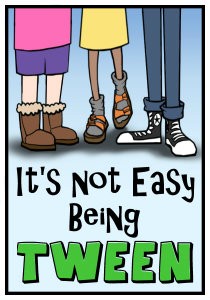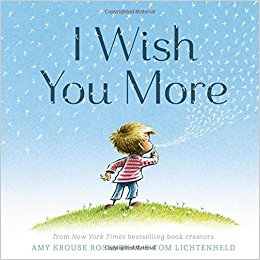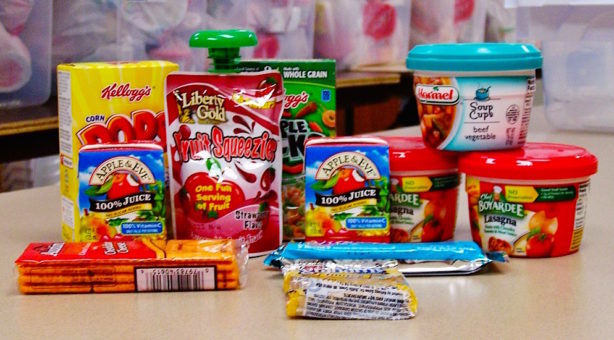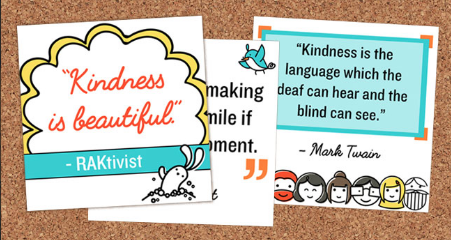The Year of Kindness Continues to Spread
A MiddleWeb Blog

Of course, occasional incidents of unkindness arise, but they are dealt with swiftly and the students are then reminded to keep kindness and empathy front of mind.
A few fun things happened this fall in addition to what I had originally planned. At a school assembly, pupils worked in cross-grade groups to determine what kindness meant to them and how they could help make the school a kinder place. The resulting posters were displayed around the lobby to good effect!
Also, there is now a Kindness Tree in the lobby where random acts of kindness ideas are hung from the branches and students may take one to perform themselves. An anonymous student also placed sticky notes with positive affirmations around the entire building. And my weekly kindness challenges are a hit even though they offer no reward except for the resulting good will.
In fact, to reinforce that kindness is its own reward, I showed a 2016 video clip of Ellen Degeneres accepting her People’s Choice Award for Choice Humanitarian. In it, she says that being nice and generous and kind isn’t something anyone should do in hopes of getting an award (specifically from 1:30 to 2:15). Instead, it’s simply something we should do as part of being human. Students are having fun sharing what happened after they performed the kind act. I am excited to see what the rest of the year brings.
I have determined my focus for the remaining months of school and look forward to keeping the momentum going.
This is the season when many children’s minds turn to gifts—primarily on the receiving end. I want to turn the tables on this and have students think about ways they can give to others. Not material goods, but rather their time and effort. I encourage them to share with the class charitable initiatives they are involved in outside of school.
In school, each grade level has adopted a specific charity with which they work. In sixth grade, we work with a local charity providing weekend meal bags for students who face food shortages.
We do a food drive for items to place in the bags, and then we go help pack them. This has had a great impact on our students who have privileges that many do not. Each school situation is different, but the act of helping others is very rewarding.
Also at the front of their minds is the need (or at least a willingness) to decorate classrooms. Again, I would like to take the focus off of wanting to just hang up lights and snowflakes and to trying a door decorating contest on the theme of kindness. They can wrap up a classroom with positive décor.
My school is signed up for the spring cohort of the Kindness Challenge, and activities for the four-week initiative begin in January. I do not currently have access to these materials, but, based on the stellar group of organizations sponsoring the challenge, they are bound to be excellent.
January 15–20 of 2018 has been designated “No Name Calling Week” by the GLSEN. Their website, glsen.org, provides a wealth of age-appropriate educator resources that I look forward to using in class. Some deal with bullying, but others address issues of name-calling, “just kidding,” and diversity.
The Random Acts of Kindness Foundation has designated February 11–17, 2018 as Random Acts of Kindness week. They encourage students to become “RAKtivists” and spread kindness throughout their community. They have fantastic lesson plans broken down by grade level. These cover a wide range of topics from “Becoming an Upstander” (6th grade) to “Coping with Stress” (7th grade) and “Peer Pressure” (8th grade). In addition, they have posted a teaser for a new kindness celebration that they are launching on November 13, which is World Kindness Day. I look forward to hearing more.
During Random Acts of Kindness week, I will encourage students to choose a Random Act of Kindness from the terrific list provided on the Random Acts of Kindness website, from the checklist posted at The Great Kindness Challenge, or the website SpreadKindness. At the end of the week, we will debrief and share our experiences.
March is short month for us as it is when we have our spring break as well as our class trip. For many of our sixth graders, the school trip is the first time they have stayed away from home without their parents. It is also the first time many of them have shared a hotel room with peers. This, understandably, causes a great deal of anxiety for many.
Two methods to help alleviate anxiety are to practice conflict resolution skills and to determine ways we can be deliberately kind to roommates and non-faculty adults they encounter on the trip. Providing some tools for getting along with roommates goes a long way in reducing the drama that can often occur in these situations.
Because the last Thursday in April is Pay it Forward day, I am extending this concept to all of April. There are several video clip options that can be used to introduce the idea. One that explains the idea comes from a CBS News On the Road report called “Kindness: Pay it Forward” which profiles a man on a mission to encourage random acts of kindness.
A great one illustrating Pay it Forward in action is called “One Day” and is made by Kindness Boomerang. Find a TED Ed lesson to go with the video here. There is even a series of videos with the theme of “Pay it Forward” from Liberty Mutual for their Responsibility Project. The Ripple Kindness Project has a video that explains the exponential effect of paying it forward along with Ripple of Kindness cards that can be distributed.
RandomActsofKindness.org has a great list of 50 Easy Ways to Pay it Forward (note: some are intended for grown-ups). We will also brainstorm other ideas for paying it forward in our school community – preferably those that go with my curriculum such as writing and illustrating a picture book for younger children.
Spread Kindness also has free Kindness Cards that can be printed and distributed to students. These cards say, “You’ve just experienced an act of kindness. Now it’s your turn to do the same.” I will give these to students to hand out after they perform their RAOK. I hope to really stir their excitement for spreading kindness.
I want to finish the year on a positive note. To that end, I want to make time for students to honor the good in their peers. There are numerous types of compliment activities shared on the internet.
One that I especially like is to have a student sit in a chair with their back to the whiteboard while their peers write compliments to them, around them. Then, with their back still to the board, I will take a photo and print out a copy for them to have. There are other versions that involve saying or writing kind things to individuals, and I think they all have value as one can never feel too valued.
Toward the end of May when students are in their most reflective mode, I want to show them Amy Krouse Rosenthal’s lovely “Thought Bubble” video at her website, whoisamy.com. asking them to think about the impact they have on the world.
I will end with sharing her quote: “At the end of life, at the end of YOUR life, what essence emerges? What have you filled the world with? In remembering you, what words will others choose?” and ask them to write a reflection piece on what they are, both what they are putting forth into society and how they wish to be remembered.

I would love to hear how your school is celebrating kindness this year.








































